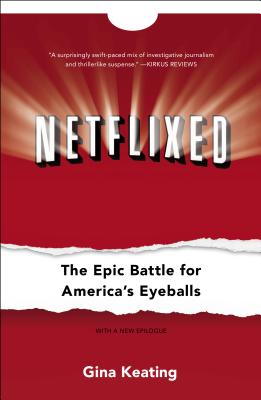
Netflixed:The Epic Battle for America's Eyeballs
Interview with Gina Keating
November 9, 2017Sign Up to listen to full interview.
About Gina Keating
Gina Keating is the author of Netflixed: The Epic Battle for America’s Eyeballs (Portfolio, 2012) and a freelance writer. She covered media, law and government as a staff writer for Reuters and United Press International in Los Angeles.
The Greater Los Angeles Press Club named her its Print Journalist of the Year in 2001. The same year, she won the Press Club’s award for investigative reporting and the California Teachers Association’s John Swett Award for excellence in education-related journalism for stories she wrote for the Los Angeles Daily Journal.
Prior to moving to Los Angeles, she covered the Texas Legislature, business and culture as a freelance writer for the Associated Press, UPI, the Austin American-Statesman, and Texas Monthly, Food and Wine, Southern Living and Forbes magazines. Her freelance work also has appeared in Daily Variety.
She lives in Los Angeles.
Interview Summary
Before Amazon disrupted the retail industry, Netflix was the bête noire of the movie industry. Marc Randolph and Reed Hastings co-founded a movie rental service that simply sent discs by mail. The business took off because customers loved a subscription model with no late fees.
As Netflix built the customer base and expanded its movie library, business growth accelerated and the entrenched movie rental retailer Blockbuster was forced to respond. In 2000, Hastings first struggled to win a partnership with Blockbuster, but after several rebuffs he went on to chart an independent course with devastating impact on the largest movie retailer at the time.
In an interview with Readara, award-winning author Gina Keating discusses what led to the rise of Netflix and how the movie rental industry slowly shifted to mail order before launching streaming services. Keating goes on to explain how the digitization and the rapid spread of the Internet led to the fall of the once-mighty retail empire of Blockbuster with its thousands of stores, millions of customers and strong marketing strategies.
In 2004, four years after Netflix was launched, John Antioco, CEO of Blockbuster, realized that Netflix and Redbox are posing a serious threat to the company. After eliminating the annoying late fees that also generated nearly $200 million in profits, he decided to invest an additional $200 million in online operations. However, in 2005, activist shareholder Carl Icahn fired the retail veteran who was taking all the right steps in countering the Netflix threat.
Netflix invested heavily in following and understanding online customer behavior and leveraged that knowledge by building a movie library and improving customer experience. Yet, the final chapter of the company may not be written, as Amazon pursues Netflix customers with a growing library of movies and other offerings at even cheaper subscription prices.
Key Topics
- How was Netflix conceived?
- Why did movie lovers prefer Netflix’s service?
- How was Netflix different from the entrenched Blockbuster chain?
- What technological challenges did Netflix face?
- What was the management style of co-founder Reed Hastings?
- How have algorithms come to rule what we watch?
- How has technology transformed our ways of accessing digital content?
- Why did Blockbuster and other retailers fail to respond to the Netflix challenge?
- What were the critical missteps that Blockbuster took?
- How did Blockbuster’s shareholder Carl Icahn contribute to the demise of the company?
- How did Netflix deal with near-death experiences during the battles with Blockbuster?
- Why are Amazon and Netflix not competing for eyeballs and subscription dollars?
